
CHAPTER 1
CO-CREATION
WHAT?
Development of vision and policy at the institutional level
CASES
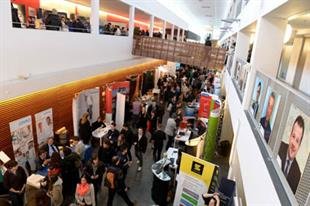
Authentic Education model
PXL University of Applied Sciences and Arts
For several years, PXL University of Applied Sciences and Arts has been investing heavily in the expansion of its contacts with the professional field in which graduates will end up. The investments are prompted by a variety of reasons, such as staff development, expansion of practice-oriented research, gearing our programmes to the needs of the professional field, innovation of the programme, et cetera. Furthermore, our contacts with the professional field are substantiated in various ways, from study days, company visits, the provision of lecturers and guest speakers who are active in the field in a professional capacity, ties with alumni, professional field committees, networking in the purview of work placements or projects, projects on behalf of and/or with the professional field, work placements, to completing bachelor’s theses. Practical integration also plays a key part in the educational philosophy of the university.
READ MORE
PXL University of Applied Sciences and Arts
Authentic Education Model
For several years, PXL University of Applied Sciences and Arts has been investing heavily in the expansion of its contacts with the professional field in which graduates will end up. The investments are prompted by a variety of reasons, such as staff development, expansion of practice-oriented research, gearing our programmes to the needs of the professional field, innovation of the programme, et cetera. Furthermore, our contacts with the professional field are substantiated in various ways, from study days, company visits, the provision of lecturers and guest speakers who are active in the field in a professional capacity, ties with alumni, professional field committees, networking in the purview of work placements or projects, projects on behalf of and/or with the professional field, work placements, to completing bachelor’s theses. Practical integration also plays a key part in the educational philosophy of the university.
The educational concept, whose key words are authenticity, innovation, and co-creation, ensures that students can develop the X factor and thus grow into excellent professionals. For their entire educational career, our students will be faced with real-life challenges, in order to acquire lifelong learning skills that enable them to function in tomorrow’s complex reality.
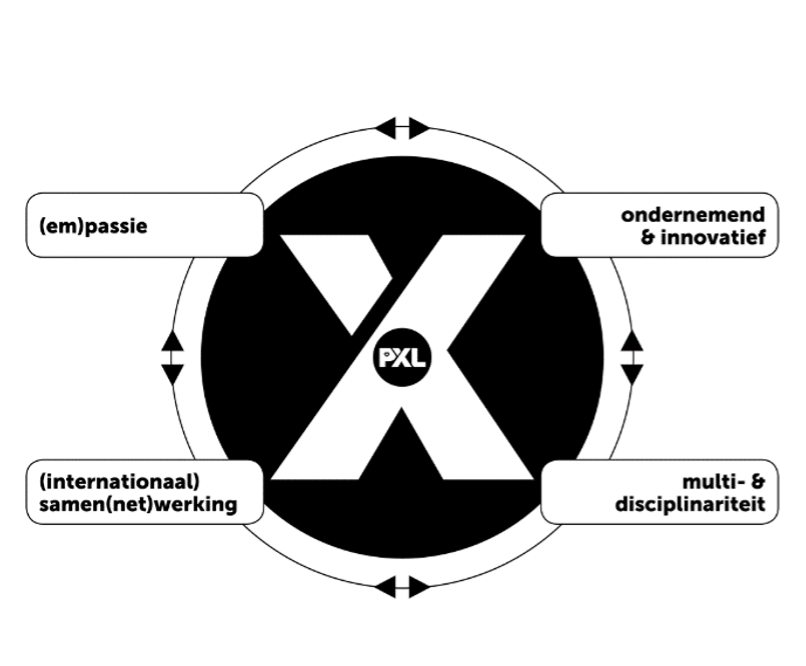
Definition of co-creation
Co-creation is a social modus operandi that demonstrates a strong affinity to the participatory working processes that are popular among businesses in Scandinavia. Involving shop floor staff in change processes enhances their commitment and thus their support for the change. Co-creation is a very interesting method that involves learning from one’s peers. Co-creation in its many variants has been booming. Many citizen initiatives and community art projects are adopting approaches based on co-creation principles. The term was coined in marketing-related contexts in which consumers are actively involved in a product’s development process.
Co-creation is especially relevant with a view to the innovative work of the future. To an increasing extent, our generation of students will be working in situations in which innovation ensues from collaboration. Furthermore, businesses/organisations are increasingly collaborating with other businesses, with professionals from other disciplines, and with end users. This is referred to as co-innovation: innovation that ensues from collaboration (Nigten, 2015).
This concept, translated into the educational context, entails that programme teams are actively involving students in educational design; that lecturers and students collaborate on projects; and, finally, that external parties are actively involved in authentic projects aimed at finding innovative solutions to practical challenges in co-creation with students and lecturers.
PXL Model for authentic education
Education at PXL University of Applied Sciences and Arts must always be authentic. This means that each and every programme component must feature a certain degree of authenticity, factoring in the above elements. However, what does this entail for the design of a curriculum and of teaching-learning activities, and where does the emphasis lie?
To support the design process, we have opted for developing our own PXL model, in which the elements of authentic context, authentic learning tasks, professional processes, reflection, and articulation of the thought process are explicit elements. The other elements of an authentic learning environment have not been explicitly accommodated in the model. However, the elements of “multiple roles and perspectives, collaboration, coaching, and authentic evaluation” are essential in the substantiation of the curriculum and the teaching-learning activities.
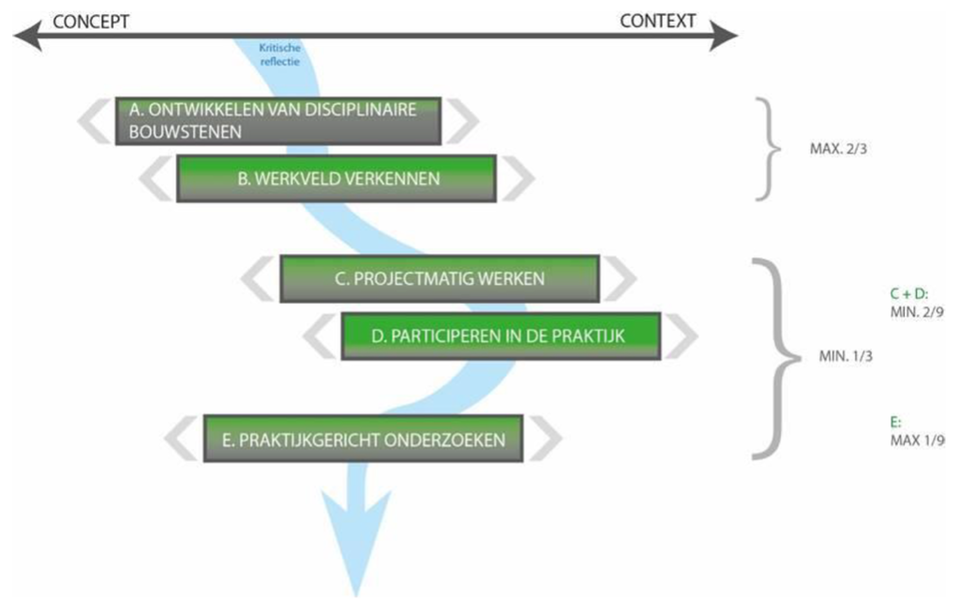
The model comprises four core elements:
- Continuous coordination between conceptualising and contextualising (horizontal axis)
This stems from the requirements that our society sets for excellent professionals. On the one hand, they need to be capable of more abstract thinking and of transcending the concrete and the material, thus finding leads for innovation and improvement of the professional practice. On the other hand, professionals are required to command thorough practical know-how and to be able to act in an expert capacity in professional practice. That is why our model distinguishes between the elements of “concept” and “context”.
Concept is the notion that we use for the theoretical models and the models that we present to students. Context is the notion with which we refer to the actual tasks, situations, and experience from the professional field that we present to students.
Education is best structured as a continuous and reciprocal process of “contextualising”, i.e., applying and specifying theoretical models and notions in concrete tasks, and “conceptualising”, i.e., abstracting specific situations and experiences, and translating them into theoretical notions and models (Bakker & Akkerman, 2014).
- The university of applied sciences as a learning environment on the one hand and the professional field as a (work-based) learning environment on the other hand (dark grey content vs. green content)
Recent studies into learning in different contexts have shown that differences in the learning environment can be conducive to study success (Vermunt & Verloop, 1999; Colley, James, Tedder, & Diment, 2003; De Bruijn, 2012; Ehlers, 2014). Within the scope of authentic learning, we need to dissolve and cross the thresholds between education and the labour market. Boundary crossing involves processes that take place at the boundaries (of practice) and that are aimed at safeguarding or restoring continuity and interaction or action. A key recommendation to programme teams is to approach students (and lecturers and external parties) as active “boundary crossers”, who continue to sound out and cross the boundaries of the university, the workplace, the discipline, practices, and so on. After all, learning at and across the boundaries of the school context and the workplace generates learning potential.
- Critical reflection throughout all the authentic teaching-learning activities (blue line)
Becoming an excellent professional also involves reflecting on the values and norms of the professional group, developing one’s own emphases, and looking at oneself and one’s development. In many programmes, this is referred to as the “personal and professional identity”. Students can reflect on several aspects: for example, on their own actions and views, on the organisation (organisational culture) in which they are working, on all the subject matter that the programme is providing, on the manner in which they (prefer to) learn, and so on.
Critical reflection can be accommodated within any authentic teaching-learning activity. Thus, rather than working solely on autopilot, students will have room to experiment and to learn from their mistakes, they will have the opportunity to share their opinions and ask critical questions, they can request feedback on their ideas and their work, and they can become aware of their learning careers.
- Five clusters of authentic teaching-learning activities (clusters A, B, C, D, and E)
All the teaching-learning activities in a curriculum are authentic to some extent. To differentiate between the various teaching-learning activities, the model is divided into clusters A, B, C, D, and E. Some teaching-learning activities are “coloured” with authentic elements (such as clusters A and B); other teaching-learning activities focus on project-based working, on exploring a practical problem, or on participating in actual practice (such as clusters C, D, and E). The teaching-learning activities in clusters C, D, and E constitute the essence of the PXL model for authentic education. The following types of teaching-learning activities are distinguished:
Cluster A: Developing discipline-related building blocks
This cluster comprises teaching-learning activities in which students are taught the building blocks (knowledge elements or basic skills) of the discipline in an interactive manner. Once taught, the building block matter is not intended to remain “dormant”. Theory is given meaning through links to reality. During these activities, students enhance their skills by applying the knowledge via exercises, by presenting substantiated arguments during peer-to-peer discussions, by conducting analyses, by interrelating components, and by critically reviewing the knowledge elements.
Cluster B: Exploring the professional field
These teaching-learning activities enable students to sample the actual professional field. During the activities, students observe professionals and/or actual professional processes as they occur in the workplace, whereupon they subsequently study the matter in depth, analyse it, and link it to theoretical concepts.
Cluster C: Project-based working
This cluster comprises all the teaching-learning activities in which (groups of) students carry out project-based assignments pertaining to an actual practical issue, whether or not in collaboration with the professional field (business community, government authorities, knowledge institutes) or with a university expertise or research unit. Final responsibility for the supervision and monitoring of the students is vested with a member of the university staff (teaching staff or researcher). In many cases, these types of teaching-learning activities are of a service-providing nature, albeit without an obligation to produce results. Their main goal is to encourage students, in a project-based manner, to find solutions to a practical issue.
Cluster D: Participating in actual practice
These teaching-learning activities afford students room for practicing, in an integrated manner, professional skills, professional expertise, and professional attitudes in a realistic professional context. In the learning situations, students assist in the day-to-day activities of their future profession. The main goal is to have students learn from experience: hands-on learning, and learning from what goes well and what goes wrong (trial and error).
Cluster E: Practice-oriented research
In this type of teaching-learning activities, students have the opportunity to innovate within an existing professional practice based on new frameworks of conceptual thought. On the basis of complex, actual practical issues, the students are encouraged to find leads to innovate and improve practical know-how and professional conduct. The activities enable them to devise, field-test, and implement new methods/procedures/products that will lead to the intended innovations.
Co-creation at three levels
- Curriculum level
- Co-creation is incorporated in the educational concept of the programme.
- The programme comprises well-considered teaching-learning activities in which co-creation plays a part.
- The first stage of the educational track comprises at least one programme component in which co-creation plays a part.
- Transparent guidelines/procedures/forms are available to organise the co-creation process (work placement, bachelor’s thesis, work-based learning, supervision of projects…).
- The programme curriculum is set up in a manner that facilitates multi-disciplinary projects in collaboration with the professional field.
- The programme designs authentic teaching-learning activities in consultation / in concert with the professional field (and other stakeholders).
- The lecturers collectively look for and use working formats and evaluation formats that familiarise students with the professional field.
- The programme builds a network of relevant businesses/organisations/institutions and enables its staff to become acquainted with or collaborate with these partners.
- Professional development of lecturers with respect to co-creation is covered in the programme’s staff development policy.
- The stakeholders are aware of the role that co-creation plays in the programme and are familiar with the underlying goals.
- The programme involves its students in the design of co-creation processes and in gauging the quality of co-creation.
- Curriculum component level
- In at least one of the programme components, students are given the opportunity to work on co-creation in accordance with the principles of project management.
- Lecturers involve external evaluators from the professional field.
- Students are aware of the evaluation criteria for co-creation teaching-learning activities.
- Lecturers provide tailored coaching during co-creation projects.
- Students are made aware of how the competencies acquired relate to their future profession.
- On the basis of a personal development plan, students can reflect on the professional competencies they have developed and on their personal development, either within or across programme components.
- Extracurricular activities
- The programme encourages students to participate in networks/activities that are relevant to the programme in which they are enrolled and to their future professional field.
- Lecturers participate in the professional field or take part in networking events, conferences or workshops that enable them to keep in touch with the professional field.
- The programme organises workshops, study days, seminars, and in-service training about topics related to the professional field.
Odisee University of Applied Sciences
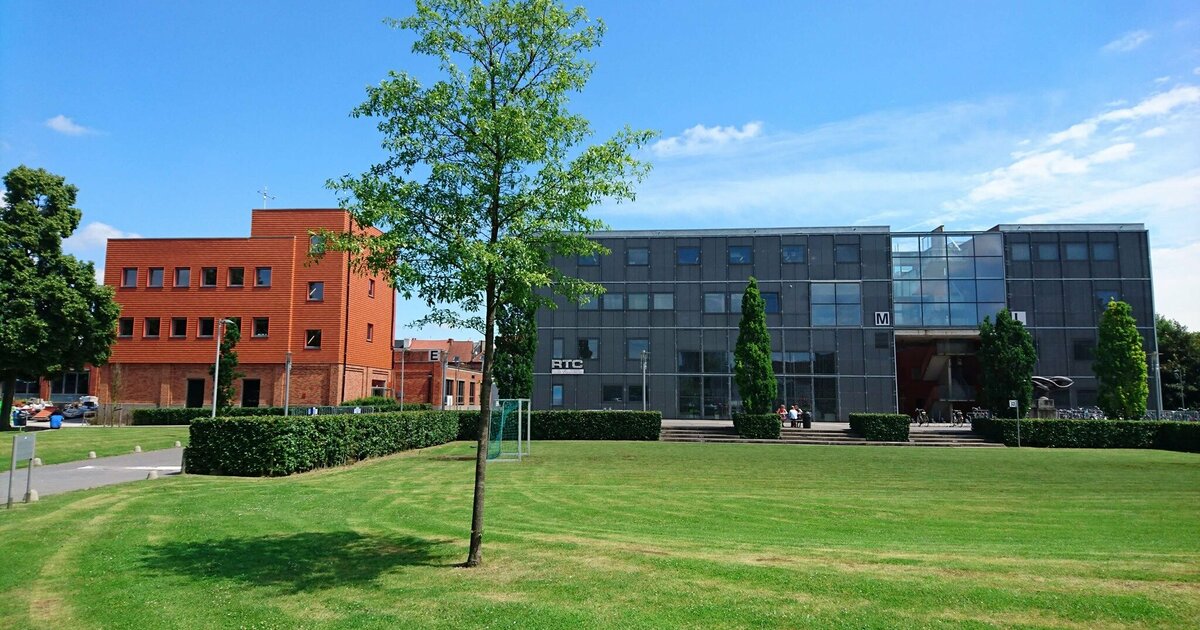
Growth Path towards Co-creation
Odisee University of Applied Sciences
Within Odisee University of Applied Sciences, co-creation and co-creation competencies form part of the solution to the complex issues of a VUCA world. This principle is anchored in its Vision 2027 and in the Institution-wide Framework for Curriculum Construction. In relation to the fourth design principle in this framework, “Actively learning in authentic and co-creative contexts”, the institution explicitly states that all its programmes must embed a growth path and a progressive pursuit of co-creation in their curricula.
Odisee University of Applied Sciences
Growth Path towards Co-creation
How does Odisee interpret co-creation?
- Co-creation is conducted by educational professionals, students, researchers, and actors from the professional field and/or from society.
- Co-creation is aimed at finding solutions to complex issues that the individual actors cannot manage to resolve on their own (no co-creation for the sake of co-creation).
- All the actors involved have an impact on the process and on its results; they contribute to the process; and they enhance one another based on their own expertise, experience, and talents (equality, mutuality).
- Co-creation serves the pursuit of a collective ambition and a collective result; the goal is to produce win-win situations.
- Extensive attention is focused on the quality of the process and of the relationships. This is a prerequisite for combining a range of perspectives and forms of expertise into collective intelligence in the pursuit of a new, valuable solution.
- In addition to the development of something new (product, service, policy, …), a co-creation process also results in the participants having learned (new knowledge/skills).
Co-creation is not a self-evident process. Various success factors determine whether or not the co-creation will be successful. An important factor is the point of departure for a co-creation process, i.e., an explicit urgency that is perceived by all the partners. Other pertinent factors include shared goals, trust, courage, and decisiveness (Ehlen, van der Klink, & Boshuizen, Co-Creatie-Wiel: instrument voor succesvolle innovatieprojecten, 2015)
Our ambition: a growth path towards co-creation
Our view on learning (learners must also be capable of developing new behaviours to address tomorrow’s new challenges; co-creation provides leverage in this respect) is contained in our Odisee 2027 vision document and in the Institution-wide Framework for Curriculum Compilation, for example, via such Odisee-wide learning results as co-creation, inter-professional collaboration, entrepreneurship, et cetera and via the principle of the learner taking responsibility. This view is most explicitly reflected in the fourth design principle: “actively learning in authentic and co-creative contexts”. The associated red line stating that all programmes are to incorporate into their curricula a growth path towards co-creation as outlined above chimes with this proposition. No more than learning how to swim on dry land can one fully learn to resolve complex professional issues on one’s own, outside an authentic work context.
Yet we cannot make absolute such authentic and co-creative contexts as educational concepts. Towards the end of their degree track, students must indeed be capable of addressing such complex challenges in a co-creative manner; however, Odisee does not maintain that its education can be interpreted as facing students with a succession of complex challenges in a variety of partnerships. Someone who expects insufficiently prepared students to address complex professional issues in the professional field is not educating them but setting them up for frustration. We prefer to take the safe road of step-by-step progression.
That is why it is important to have co-creation embedded in a more comprehensive view on proper education. The formula below links the concept of co-creation to the encompassing wider educational process.
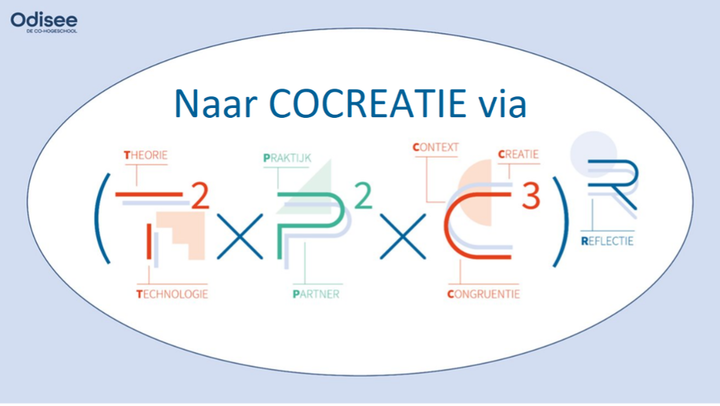
Every student and future professional needs a Theoretical knowledge basis. However, this will be limited in terms of both breadth and depth, because no-one is capable of knowing everything about his field of expertise nor of following every relevant innovation. It is important for students to learn how to cope with such limitations while still at school. They need to be able to find missing information and to engage in interdisciplinary collaboration with other parties commanding complementary knowledge and skills.
A 21st-century professional is only worthy of this title when capable of applying the appropriate Technology in his professional practice. This will enhance the quality and the efficiency of said practice.
Universities of applied sciences are Practice-oriented in terms of their teaching, their permanent education, and their research. However, this practice is in a continuous state of flux. Here, too, students must seek a balance between delving into one particular section and appreciating what is happening in other sections of the practice.
All this can only be achieved in close collaboration with Partners who are willing to translate their know-how into state-of-the-art practice. Such partners are convinced of the necessity and added value of co-creation, with each participant contributing on the basis of his own expertise, experience, and talent.
Students must learn to deal with different Contexts, as the amalgamation of theory, technology, and practice cannot be taken for granted. Students must, therefore, proactively enter into relationships, engage in open communication with respect for each party’s individuality, and be allowed room to make mistakes.
Creation means: contributing to something new, something that is challenging and relevant to both the professional field partner and the programme’s students, lecturers, and researchers. This extends beyond applying knowledge and skills in the work placement practice.
The university of applied sciences aims to provide congruent education, to set a good example, to clarify the choices that it makes based on its views to students and to partners, and to substantiate such choices by reference to sources.
Reflection, finally, both individually and in a group, enables learning across specific theories, technologies, practices, partners, contexts, and creations. This is the only way for students to become sustainable, flexible, inquisitive, and enterprising professionals.
A growth path towards co-creation logically entails that the values of each of the factors in the process will continue to change. For example, in the first stage of the programme, comparatively more attention will perhaps be focused on theory rather than on creation. However, in the final stage of the programme, a student engaged in co-creation with a partner from the professional field and with a researcher from the programme will still be pursuing specialist knowledge to be applied in new, appropriate ways. The second important evolution in the process involves the increasing interaction, throughout the programme, between the factors identified in our definition. For example, a student will reflect on responses from various partners to a creative solution that he is proposing with respect to a shared shop floor issue. Students learn to recognise the interconnectivity between all these factors; learning to deal proactively with such factors in a complex reality undoubtedly requires an analogous growth process among teachers as well as considerable mutual trust.
READ MORE